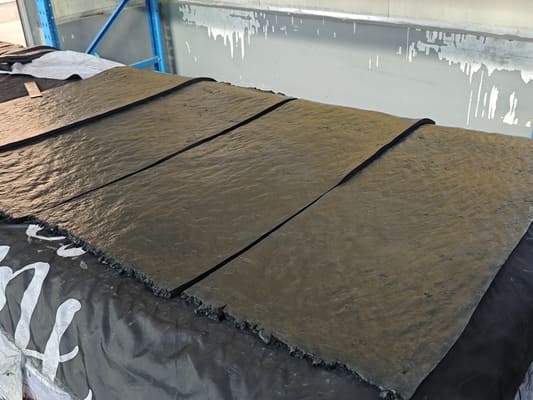Vulcanized rubber is a cornerstone material in a variety of industries, from automotive to manufacturing. Its unique properties make it an essential material for durable, high-performance products.
Vulcanized rubber is used in many applications, such as Car tires, industrial seals, and gaskets, because of its increased strength, elasticity, and heat resistance. Understanding its applications and characteristics is crucial for selecting the right material for your needs.

Vulcanization is a chemical process that transforms raw rubber into a more durable and elastic material. This process significantly enhances rubber's strength, resilience, and resistance to wear and tear, making it a valuable resource across industries. Let’s take a deeper dive into its various uses and potential drawbacks.
Are Car Tires Vulcanized Rubber?
Car tires1 are indeed made of vulcanized rubber2. The vulcanization process enhances the rubber's durability, elasticity, and heat resistance—qualities that are crucial for a tire’s performance. Tires are subjected to constant friction, temperature changes, and high pressure, all of which can cause standard rubber to degrade quickly. By vulcanizing the rubber, it becomes more resilient and able to withstand these stresses.
Vulcanization improves the rubber's ability to handle extreme temperatures, resist wear and tear, and endure the pressure exerted by a vehicle's weight. Additionally, the rubber in tires is often mixed with other compounds such as carbon black and silica, further improving the tire’s performance.
Yes, car tires are made from vulcanized rubber, which allows them to endure high pressure, temperature fluctuations, and wear over time.

How to Tell if Rubber Is Vulcanized?
Identifying vulcanized rubber can be tricky if you don’t know what to look for. There are a few methods that can help:
-
Flexibility Test
Vulcanized rubber is much more flexible than raw rubber, especially at higher temperatures. If you bend the rubber and it quickly returns to its original shape without cracking, it is likely vulcanized. -
Temperature Resistance
Vulcanized rubber can resist higher temperatures than raw rubber. If the rubber performs well in hot environments without losing its shape or melting, it is most likely vulcanized. -
Surface Hardness
Vulcanized rubber is harder and more durable compared to raw rubber. If you notice that the rubber feels tough and less prone to stretching or tearing, it's a sign of vulcanization. -
Tactile Test
Raw rubber tends to feel more sticky to the touch. If the rubber feels smooth and resistant to damage from scratching, it's a sign it may have been vulcanized.
You can tell if rubber is vulcanized by testing its flexibility, heat resistance, and surface hardness.
What Are the Negative Effects of Vulcanized Rubber?
While vulcanized rubber has many benefits, it also comes with some drawbacks:
-
Environmental Impact
Vulcanized rubber is non-biodegradable, meaning it does not break down easily in the environment. This can contribute to environmental pollution, particularly when tires or other rubber products are discarded in landfills. -
Health Concerns
Some chemicals used in the vulcanization process, such as sulfur and accelerators, can potentially cause skin irritation or respiratory issues if not handled properly. In industrial settings, proper ventilation and safety measures are necessary to mitigate these risks. -
Degradation Over Time
Although vulcanized rubber is durable, it is still susceptible to degradation when exposed to ozone, UV rays, and certain chemicals. Over time, vulcanized rubber can become brittle and crack, especially if not maintained properly. -
Cost
The vulcanization process adds extra costs to rubber production, making vulcanized rubber products more expensive than their non-vulcanized counterparts.
While vulcanized rubber is highly durable, it can have environmental, health, and long-term degradation concerns, making it important to consider the application before use.
Does Vulcanized Rubber Melt?
Vulcanized rubber does not melt in the same way that raw rubber or other thermoplastics do. Instead of melting, vulcanized rubber becomes harder and more brittle when exposed to high temperatures. At extreme temperatures, it may soften slightly, but it does not become a liquid or flow like many other materials.
The heat resistance of vulcanized rubber is significantly higher than that of raw rubber. However, at very high temperatures, vulcanized rubber can begin to degrade, losing its elasticity and structural integrity.
Vulcanized rubber does not melt, but it can degrade or become brittle under extreme heat over time.
Is Vulcanized Rubber Safe?
Vulcanized rubber is generally considered safe for a variety of uses, especially in products like tires, seals, and gaskets. The vulcanization process makes rubber more stable, durable, and resistant to wear, heat, and chemicals. This enhances safety in applications like automotive, medical devices, and industrial machinery.
However, exposure to certain chemicals during the vulcanization process can cause harmful effects. In general, vulcanized rubber is safe for most everyday uses but should be handled with care in industrial environments.
Vulcanized rubber is safe for many applications, but care should be taken to avoid exposure to harmful chemicals during the manufacturing process.
What Is the Difference Between Rubber and Vulcanized Rubber?
The key difference between rubber and vulcanized rubber lies in their structure and properties. Raw rubber, also known as natural rubber, is a flexible and soft material that can be easily shaped but lacks durability and heat resistance. Vulcanization, which involves heating rubber with sulfur and other additives, creates cross-linked bonds between rubber molecules, giving the material greater strength, elasticity, and heat resistance.
Here’s a comparison of raw rubber and vulcanized rubber:
| Property | Raw Rubber | Vulcanized Rubber |
|---|---|---|
| Strength | Low | High |
| Elasticity | High | Very high |
| Heat Resistance | Low | High |
| Durability | Low | High |
| Cost | Lower | Higher |
| Environmental impact3 | Biodegradable | Non-biodegradable |
Vulcanized rubber is much more durable and suitable for demanding applications like automotive tires, industrial seals, and medical equipment. In contrast, raw rubber is more suitable for products that do not face extreme wear or environmental challenges.
Vulcanized rubber is stronger, more elastic, and heat-resistant compared to raw rubber, making it ideal for high-performance applications.
Conclusion
Vulcanized rubber is widely used for its enhanced strength, elasticity, and resistance to heat and wear. It’s a critical material in industries like automotive, industrial, and medical fields. Despite some negative effects like environmental impact and cost, its benefits far outweigh these concerns, making it a top choice for many high-performance applications.
-
Discover the manufacturing process of car tires and how vulcanized rubber enhances their performance and durability. ↩
-
Explore the diverse applications of vulcanized rubber to understand its importance in various industries. ↩
-
Learn about the environmental concerns associated with vulcanized rubber and the importance of sustainable practices in its use. ↩






